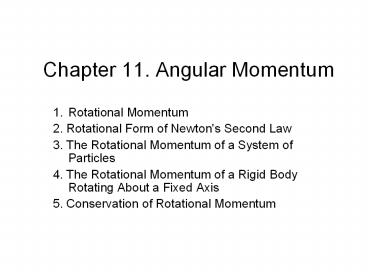Chapter 11. Angular Momentum - PowerPoint PPT Presentation
Title:
Chapter 11. Angular Momentum
Description:
During the rest of the flight he is in a tight tuck, with rotational inertia I2 = 3.93 kg m2. ... w2 around his center of mass during the tuck? Example 4 ... – PowerPoint PPT presentation
Number of Views:420
Avg rating:3.0/5.0
Title: Chapter 11. Angular Momentum
1
Chapter 11. Angular Momentum
- Rotational Momentum
- 2. Rotational Form of Newton's Second Law
- 3. The Rotational Momentum of a System of
Particles - 4. The Rotational Momentum of a Rigid Body
Rotating About a Fixed Axis - 5. Conservation of Rotational Momentum
2
Rotational Momentum
- A particle of mass m with translational
momentum P as it passes through point A in the xy
plane. - The rotational momentum of this particle with
respect to the origin O is
is the position vector of the particle with
respect to O.
Note (1) Magnitude of rotational momentum is
Lr- PrP- (2) The particle does not
have to rotate around O
3
Excise
- In the diagrams below there is an axis of
rotation perpendicular to the page that
intersects the page at point O. Figure (a) shows
particles 1 and 2 moving around point O in
opposite rotational directions, in circles with
radii 2 m and 4 m. Figure (b) shows particles 3
and 4 traveling in the same direction, along
straight lines at perpendicular distances of 2 m
and 4 m from point O. Particle 5 moves directly
away from O. All five particles have the same
mass and the same constant speed. (a) Rank the
particles according to the magnitudes of their
rotational momentum about point O, greatest
first. (b) Which particles have rotational
momentum about point O that is directed into the
page?
4
Rotational Form of Newton's Second Law
- The (vector) sum of all the torques acting on a
particle is equal to the time rate of change of
the rotational momentum of that particle.
5
Sample Problem 1
- In Fig. 11-14, a penguin of mass m falls from
rest at point A, a horizontal distance D from the
origin O of an xyz coordinate system. (The
positive direction of the z axis is directly
outward from the plane of the figure.). a) What
is the angular momentum of the falling penguin
about O? b) About the origin O, what is the
torque on the penguin due to the gravitational
force ?
6
The Rotational Momentum of a System of Particles
- The total rotational momentum of a system of
particles to be the vector sum of the rotational
momenta of the individual particles
7
Newtons Law for a System
- The net (external) torque acting on a system of
particles is equal to the time rate of change of
the system's total rotational momentum .
8
The Rotational Momentum of a Rigid Body Rotating
About a Fixed Axis
- The angular momentum L of a body rotating about
a fixed axis is the product of the bodys moment
of inertia I and its angular velocity ? with
respect to that axis - Unit of Angular Momentum kgm2/s
9
CONSERVATION OF Rotational MOMENTUM
- The total angular momentum of a system remains
constant (is conserved) if the net external
torque acting on the system is zero.
10
- If the component of the net external torque on
a system along a certain axis is zero, then the
component of the angular momentum of the system
along that axis cannot change, no matter what
changes take place within the system.
11
examples
12
Corresponding Relations for Translational and
Rotational Motion
13
Example 2 A Satellite in an Elliptical Orbit
- An artificial satellite is placed into an
elliptical orbit about the earth, as in Figure
9.27. Telemetry data indicate that its point of
closest approach (called the perigee) is
rP8.37106 m from the center of the earth, and
its point of greatest distance (called the
apogee) is rA25.1106 m from the center of the
earth. The speed of the satellite at the perigee
is vP8450 m/s. Find its speed vA at the apogee.
14
EXAMPLE 3
- During a jump to his partner, an aerialist is
to make a quadruple somersault lasting a time
t 1.87 s. For the first and last quarter
revolution, he is in the extended orientation
shown in Fig. 12-20, with rotational inertia
I1 19.9 kg m2 around his center of mass (the
dot). During the rest of the flight he is in a
tight tuck, with rotational inertia I2 3.93 kg
m2. What must be his rotational speed w2 around
his center of mass during the tuck?
15
Example 4
- A uniform thin rod of length 0.500 m and mass
4.00 kg can rotate in a horizontal plane about a
vertical axis through its center. The rod is at
rest when a 3.00 g bullet traveling in the
rotation plane is fired into one end of the rod.
As viewed from above, the bullets path makes
angle ?60o with the rod (Fig. 11-52). If the
bullet lodges in the rod and the angular velocity
of the rod is 10 rad/s immediately after the
collision, what is the bullets speed just before
impact?
16
Conceptual Questions
- 1 A woman is sitting on the spinning seat of a
piano stool with her arms folded. What happens to
her (a) angular velocity and (b) angular momentum
when she extends her arms outward? Justify your
answers. - 2 A person is hanging motionless from a
vertical rope over a swimming pool. She lets go
of the rope and drops straight down. After
letting go, is it possible for her to curl into a
ball and start spinning? Justify your answer.































